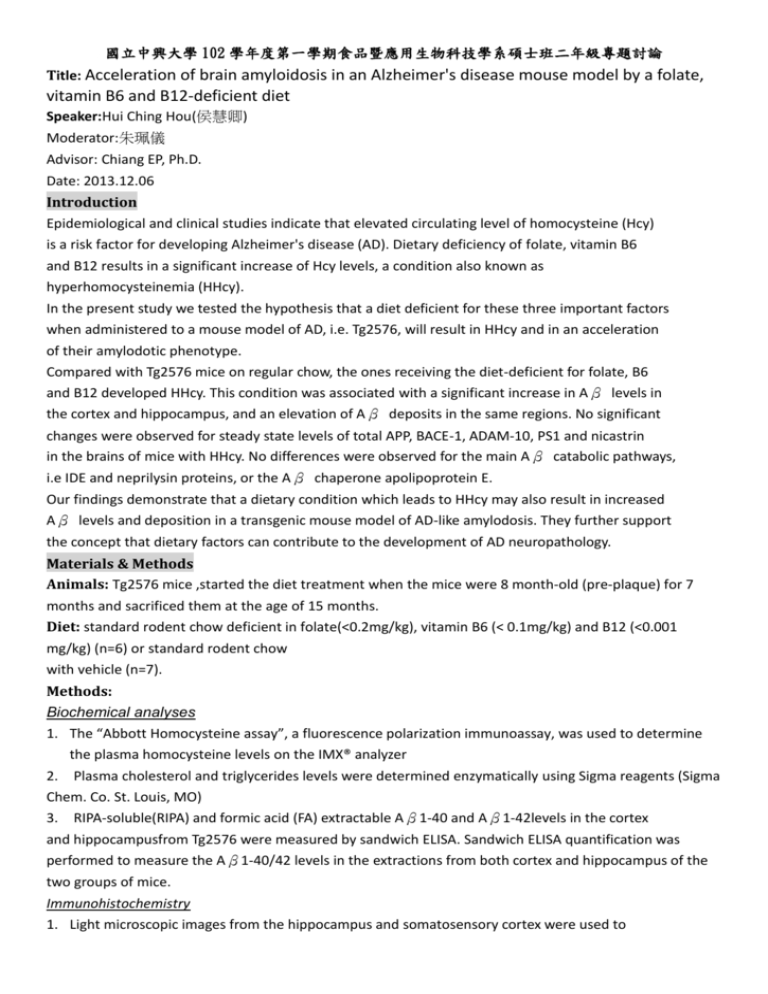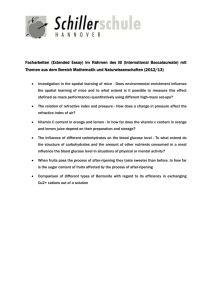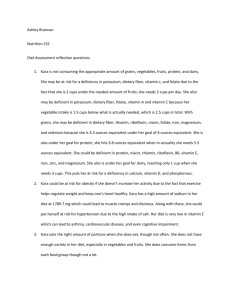國立中興大學102學年度第一學期食品暨應用生物科技學系碩士班二
advertisement

國立中興大學 102 學年度第一學期食品暨應用生物科技學系碩士班二年級專題討論 Title: Acceleration of brain amyloidosis in an Alzheimer's disease mouse model by a folate, vitamin B6 and B12-deficient diet Speaker:Hui Ching Hou(侯慧卿) Moderator:朱珮儀 Advisor: Chiang EP, Ph.D. Date: 2013.12.06 Introduction Epidemiological and clinical studies indicate that elevated circulating level of homocysteine (Hcy) is a risk factor for developing Alzheimer's disease (AD). Dietary deficiency of folate, vitamin B6 and B12 results in a significant increase of Hcy levels, a condition also known as hyperhomocysteinemia (HHcy). In the present study we tested the hypothesis that a diet deficient for these three important factors when administered to a mouse model of AD, i.e. Tg2576, will result in HHcy and in an acceleration of their amylodotic phenotype. Compared with Tg2576 mice on regular chow, the ones receiving the diet-deficient for folate, B6 and B12 developed HHcy. This condition was associated with a significant increase in Aβ levels in the cortex and hippocampus, and an elevation of Aβ deposits in the same regions. No significant changes were observed for steady state levels of total APP, BACE-1, ADAM-10, PS1 and nicastrin in the brains of mice with HHcy. No differences were observed for the main Aβ catabolic pathways, i.e IDE and neprilysin proteins, or the Aβ chaperone apolipoprotein E. Our findings demonstrate that a dietary condition which leads to HHcy may also result in increased Aβ levels and deposition in a transgenic mouse model of AD-like amylodosis. They further support the concept that dietary factors can contribute to the development of AD neuropathology. Materials & Methods Animals: Tg2576 mice ,started the diet treatment when the mice were 8 month-old (pre-plaque) for 7 months and sacrificed them at the age of 15 months. Diet: standard rodent chow deficient in folate(<0.2mg/kg), vitamin B6 (< 0.1mg/kg) and B12 (<0.001 mg/kg) (n=6) or standard rodent chow with vehicle (n=7). Methods: Biochemical analyses 1. The “Abbott Homocysteine assay”, a fluorescence polarization immunoassay, was used to determine the plasma homocysteine levels on the IMX® analyzer 2. Plasma cholesterol and triglycerides levels were determined enzymatically using Sigma reagents (Sigma Chem. Co. St. Louis, MO) 3. RIPA-soluble(RIPA) and formic acid (FA) extractable Aβ1-40 and Aβ1-42levels in the cortex and hippocampusfrom Tg2576 were measured by sandwich ELISA. Sandwich ELISA quantification was performed to measure the Aβ1-40/42 levels in the extractions from both cortex and hippocampus of the two groups of mice. Immunohistochemistry 1. Light microscopic images from the hippocampus and somatosensory cortex were used to calculate the area occupied by Aβ-immunoreactivity with the software Image-Pro Plus for Windows version 5.0. Immunoblot analyses RIPA fractions of cortex homogenates were used for immunoblot analyses, as hippocampus homogenates were not enough for all the analyses. Samples were electrophoresed on Trisglycine polyacrylamide gels and pre-casted gels (Bio-Rad Laboratories, Hercules, CA, USA) and transferred onto nitrocellulose membranes. Statistical analysis Data analyses were performed using SigmaStat. Statistical comparisons between the different treatment groups were performed by one way ANOVA and Fisher's test post hoc analysis. Values in all figures represent mean ± S.E. Results & Discussion A Folate, vitamin B6 and vitamin B12 deficient diet induced HHcy in Tg2576 mice At the end of the diet treatment, body weight, plasma total cholesterol and triglycerides levels were not significantly different between these two groups (Table 1). The diet group had a significant higher level of plasma homocysteine than the ctrl group (Fig. 1). HHcy elevated Aβ peptide levels in Tg2576 mice brain Observed a significant increase of Aβ1-40 levels in the FA fraction of the hippocampus. Moreover, Aβ1-42 was significantly increased in both RIPA and FA extracted fractions of the cortex(Figure 2) HHcy increased Aβ deposition in Tg2576 mice brain Immunochemical detection of Aβ peptides deposition in the brain sections were performed with 4G8, an anti-Aβ antibody reactive to amino acid residues 17-24. As shown in figure 3, we found that, compared with the control group, the group with HHcy had a significant increase in Aβ immuno-reactivity in both the hippocampus and th esomatosensory cortex areas (SSC). HHcy and APP metabolism in Tg2576 mice brain (Figure 4&5) Compared with brain homogenates from the control group, total APP level from the mice with HHcy was not different (Figure 4).β-site APP cleaving enzyme (BACE-1), and sAPPβ, Diet-induced HHcy did not result in any significantly alteration of the α-secretase measured by the sAPPα, C-terminal fragment-α (CTF-α; C83) and ADAM-10 levels, when compared with controls. γ-secretase complex, PS1 and Nicastrin, showed no difference between two groups. However, C-terminal fragment-β (CTF-β; C99) level was statistically significant lower in the brains of the diet group.Insulin-degrading enzyme (IDE) and neprilysin (NEP)apoE are no different. Conclusion our study demonstrates that a folate, vitamin B6, and B12 deficient diet induces HHcy in an AD-like mouse model, and associates with a significant acceleration of their amyloidotic phenotype. Since Aβ plays a central role in AD pathogenesis, our results further support the concept that dietary factors could contribute to the AD neuropathology. Reference 1.Hyperhomocysteinemia increases beta-amyloid by enhancing expression of gamma-secretase and phosphorylation of amyloidprecursor protein in rat brain. [PubMed: 19264913] 2. Impaired spatial memory in APPoverexpressing mice on a homocysteinemia-inducing diet. Neurobiol Aging [PubMed: 16837103]








